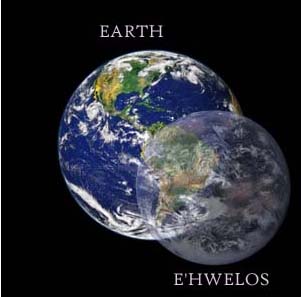E'hwelos
Overview:
E'hwelos is an Earth-like planet that exists within the Siopicus Dimension (a dimension similar to the universe, but unseen or felt) on a higher vibration than that of the Earth. It also has a single moon, but its energy is drawn from the sun of Earth's solar system, whose radiation particles penetrate into the E'hwelian atmosphere and interact with its 'salenian' gasses, creating a wonderous purple hue in the evening, and a reddish hue during daylight. E'hwelos is actually situated partly within the Earth (see image below) and is dragged along in its orbit. Its size is roughly 1/3 than that of Earth. Although the Siopicus Dimension is attached to the universe and timeline, the higher vibration means that E'hwelos and indeed its own universe cannot been seen or felt by those on Earth. However, E'hwelian beings are a good deal more biologically advanced than humans, and can lower their biological vibrations, enabling them to interact with those on Earth (though for the most part, only for short periods of time, and its often these visits that are mistaken for spiritual or ghostly sightings).
Quick facts:
- The E'hwelian timeline is equivalent to Earth's, but E'hwelos revolves faster making its full day 23 hours. However, because the planet spins within Earth and not in its own orbit around the sun, this makes the E'hwelian year around 15 days longer than Earth's. Therefore an E'hwelian year is equivalent to approx 381 earth days.
- The planet consists of 4 continents: 1 whole continent lies in the northern hemisphere, 2 whole continents in the southern, and the 4th lies mostly in the southern hemisphere with approx 1/3 lying in the northern hemisphere.
- E'hwelos experiences similar seasons to Earth's, that is to say they have a winter, spring, summer and autum, although the climate is around 5 degrees warmer overall. If humans were to experience an E'hwelian summer, it would be somewhat uncomfortable.
- The population is approx 2.5 billion.
- There are 22 countries.
- There are only 2 official languages: Utan (the original language of the Utai) and Ithibu. Utan is spoken naturally by the Utai, and an Utan dialect known as Hutan is spoken naturally by the H'wero. Ithibu has a standard form, but many dialects. (Note: The Utai do not speak Utan exclusively; if an Utai is born in an Ithibu speaking country, then they will learn that as their 1st language, although genetically, they will naturally learn Utan).
- The official auxilliary language (similar in which English is classed as an international language) is Utan.
- Most of the animals and plants that exist on earth also exist on E'hwelos, although there are plants and animals that exist on E'hwelos that do not exist on Earth.
- E'hwelian atmospheric gasses that do not exist on Earth create its violet hue in the evening and its reddish hue in the daytime.
- E'hwelian water consistency is different, almost mercury-like. Its oceans are crystal clear, due to an ocean dwelling bacteria called 'delingamellanoin' that devours dirt particles.
- It never gets dark, only the colour changes in the evening.
A stunning evening view of the Eth'hwaani lake
Civilisation
Speaking in an 'evolutionary' sense, the E'hwelian civilisation is not that disimilar to our own; that is to say, they have a 'Human' race. However, there are 3 specific types of human (or 'race' as in 'human race', not as in 'ethnicity) on E'hwelos. In fact, one could say (definately in the case of the Utai) that there are 3 'species' of human. They are:
- The Uta
- The H'wero
- The Ithibu
The reason I don't say they are different 'races' is because their DNA is inherently different to the point where they cannot cross-breed (reproductive isolation). For example: on earth, although they have different facial characteristics, skin tone and in some instances, genes, Caucasians (white), native Africans (or any member of a black race), and Asians can mate with each other and successfuly produce fertile offspring. Therefore, the E'hwelian humans (for now) should be refered to as 'species' since technically speaking, different species cannot produce offspring. That said, it is actually possible for Utai and H'wero to produce offspring, although they will only produce a female who will be infertile . For this reason, strict precautions are taken to ensure non pregnacy between the two. Unfortunately, there are still a significant number of Utero born each year. Fertilization between Utai (male) and Ithibu (female) brings about misscariage and can cause serious health issues for the female.
All E'hwelians have a reddish skin tone, although the degree of tone varies between species and continent.
Uta
The Uta species is, in comparison with earth humans, a highly advanced, and the most numerous at around 800 million. Here are some Uta facts:
- Utai have redder skin tone than the other species. When pregnant, the females skin tone becomes deeper and the eyes slightly luminescent.
- Utai have 'redundant' lungs; that is to say they have no use for distributing oxygen. Their skin is developed to absorb and distribute oxygen directly into the bloodstream. The lungs of an Uta are however, necessary to enable them to talk, as the vocal chords still rely on air flow to cause vibration. Noticeably, an Uta will only breath when talking.
- They have very distinctive facial features, such as: thin lips, small-slender eyes (most males have violet colour; the females silver or white), small-rounded ears, and have either very dark to black or blonde hair.
- Their senses are very acute: eyesight is around 3-4 times sharper than that of ours, as is their hearing and sense of smell.
- Physically, the males are tall (over 6 feet), generally quite stocky with good muscular definition, and up to 5 times stronger than ourselves. The females are mostly of the same height, though slender in build, and have thinner noses but thicker lips, and also quite strong.
- There are 2 very distinct traits of the Utai which set them apart from the other species: their telepathic and healing abilities. All Utai are born with these abilities, and is inherent in their DNA. They are capable of telepathically communicating over hundreds of miles; easier to other Utai but a lesser degree to other species. However, this is not something that is used on a 'willy nilly' basis, as it takes a great deal of concentration and can leave the user quite drained. They also have a strange affinity with animals (though not through direct communication; its thought that they can make their feelings known to animals through telepathy).
- The Utai can heal up to ten times faster than humans, and their immune system is capable of tackling and destroying diseases equivalent to cancer.
- Utai can 'transfer' feelings to others simply by touch. In other words, if an Uta wishes another person to 'feel' how they are feeling, they can do this by holding the hand of the recipient. (If only humans could do that)!
Personality
The typical Uta personality displays friendliness, happiness, respect, and love. It's rare for Utai to fall out with each other (though not improbable). In fact, like their telepathic abilities, these traits are inherent in their DNA.
- A downside to this is their indifference to 'hate' and 'malice', something which sadly still exists in the race of the Ithibu. This can often lead to shameful ridicule towards the Utai, as they often dont understand when they are being ridiculed under sarcasm from the Ithibu. However, this is not to say that the Utai are stupid, far from it!
Below: typical Uta males or Uto
and typical Uta females or Uti
H'wero
The H'werian race are similar to the Utai, and phyisically (externally) almost identical, except that their lungs are used to distribute oxygen (as ours). Their abilities in telepathy or self healing are also quite limited in comparison to the Utai. Another distinct difference is that the H'werai are acutely aware of the emotion of hate, unlike the Utai. The Ithibu can often find it difficult to distinquish the difference between the two, but Utai and H'werai can instantly tell one another apart by instinct. One way to tell the two apart of course is to watch them breath-Utai only breath when they talk, H'werai breath constantly.
Personality
The H'werai share similar personality traits with the Utai, save for their better understanding of hate and sarcasm.
The Ithibu
The Ithibu are almost identical to our human race, except that they're physically stronger and their immune systems are much more efficient. There are no distinquishing features to note, like those of the Utai and H'werai.
Personality
The Ithibu are just like us. They are capable of all traits we humans have and display. They also have a deep rooted hatred of the Utai, which has caused many problems in previous times.
By the way, if you'd like to know how come I know so much about a dimension that is 'supposedly' unseen or felt by those on Earth, click here
Languages
Utan overview
The language of the Utai is the most widely spoken language on E'hwelos. Utan is mainly agglutinative with inflectional features. Verbs inflect for, person, number, tense and modality, and nouns agglutinate for prepositional values, cause and possession. Because of this, word order is of no great importance but there is a tendancy to follow an SVO sequence. Presently, I have no examples of written Utan, therefore, for presentation and transliteration purposes, I have developed the following guidelines:
Vowels:
- a as in bat
- e as in wet (word initial is pronounced as ay in way)
- i as in wit
- o as in boat
- u as in up
- aa as in father
- ee as in street
- oo as in school
- oe as in the German schön, or the er in runner
NOTE: Where the vowel is long (and therefore represented as a doubled vowel), this will by default be a stressed syllable. This also applies to diphthongs and triphthongs.
Dipthongs:
- oi as in loin
- ae as in ay-ee (wait as in English received pronunciation)
- ai as in why
Tripthongs:
- aiu as in ey-oo
- oia as in oy-ya
Consonants: (the following are as English)
b k d f g h l m n p r s t v w x z
There is no y (except perhaps in the sound created by palatalization) or qu. The pronunciation of voiced consonants is hard to replicate in our tongue. Its almost 'breathy' like, as if the lips and throat with plosives and fricatives are not completely closed.
Palatalization and syllable stress
Palatalization and syllable stress are extremely important grammatical features of Utan. They can mean the difference between a verb and a noun, a verb tense, and especially with stress, the difference between numbers. Voice intonation also goes hand in hand with stress.
Palatalization
Palatalized consonants are: d,l,m,n and p and are rendered as follows:
d-di l-li m-mi n-ñ p-pi (for those who do not know what palatalization is, listen to the n in the Russian nyet)
Syllable stress
This is quite predictable in Utan-unlike in English where it is lexical and has to be learned with the word. However, when I say predictable, this means where it is important. In verbs, (and all verbs are trisyllablic in an uninflected state) syllable stress always falls on the 2nd syllable (uninflected). Where the verb is conjugated, stress shifts to accommodate its original position, although for emphasis, stress may also be given to the person inflection:
behiilna-to exist, ebehiilna-I exist, ébehiilna-I DO exist
It should be noted that syllable stress is only grammatical in verbs, numbers, and verbal nouns. With other word classes, including free nouns, stress may naturally fall on the 2nd syllable, and although this can change due to dialect, it will have no specific meaning. In written Utan, syllable stress is only marked in foreign correspondance-unlike palatalization which is always marked. Athough the rules of syllable stress are fairly rigid, I have decided to mark this in transliteration, but only if it is grammatically necessary. To show this, the vowel in the stressed syllable will be marked as follows:
á, é, ii, ó, ú
NOTE: ii does not make the vowel long. The above characters only represent syllable stress, they do not change the vowel sound. For long and short vowels, see the vowel section above. However, by default, a long vowel will normally always be part of a stressed syllable.
Verbs
All verbs are very regular. Verb stems or infinitive conatin 3 syllables, and the present tense always begins with a voiced consonant. This is important in pronunciation, as unvoicing changes the verbs meaning. (Utan ears are extremely sensitive to this syntactic rule, much more so than ouselves. In fact, Utan pronunciation is hard to replicate in our tongue). As said, palatalization also plays an important role in meaning. The present indicative also carries the present progressive tense ‘ing’.
Tenses:
Eg verb: behiilna-to exist/live
Present:
- behiilna-infinitive-to exist
- ebehiilna-I exist/am existing
- abehiilna-you exist (singular)
- ambehiilna-you (all) exist
- obehiilna-he exists
- ubehiilna-she exists
- eibehiilna-it exists
- enbehiilna-we exist
- onbehiilna-they exist
- inbehiilna-one exists
Simple past:
Unvoicing of word initial consonant. This tense doesn’t always denote completion of an action:
- epehilna-I existed/did exist/was existing (then same for all conjugations)
Perfect present:
Formed by way of palatalization of the last consonant:
- epehiilña-I have existed (pronounced 'epehilnya')
Future:
Adds n to the stem:
- ebehiilnan-I will exist
There is no perfect future tense.
Copula and the verb 'to be'
The verb vaana-to be, has 3 uses in Utan. It’s main use is to act as a copula to adjectives, but is also used to link nouns and pronouns to a prepositioned noun, and as a copula for stative/intransitive verbs. It’s quite hard to directly translate this into English. Vaana roughly denotes the 'state' of something, or the current status of the subject, and only conjugates for tense when used with nouns.
- vaana-am/is/are
- faana-was/were/had been
- faaña-have/has been
With adjectives:
- Faen-hot (adjectives denote the was/were state with the ending o)
- Hwen vaana faen-I am hot (rough translation: I'm in a state of being hot)
- Noi vaana faen-you are hot
- Ema vaana faen-he is hot
- Hwen vaana faeno-I was hot
With verbs:
Zihoina-to own, gehuna-to kick
- Ezoina vaana olatse-I own a house (vaana needed as own is stative)
- Ogehuna oitak -He kicks a ball (vaana not needed as kick is an action verb)
NOTE: The Utai are very literall people, and this transcends into their language. For example, an Uta would never say: Evenoida vaana gwel-I feel ill. They would simply say: Hwen vaana gwel-I am ill.
Modality
Modality or the mood of a verb is rendered with an n inflection followed by a mood indicating vowel or dipthong. Modals rendered in Utan are:
- Can (to be able to)
- May (to be allowed to)
- Should (to ought to)
- Like (to like/enjoy)
- Would like (would like to)
- Want (to want to)
Other moods are:
- conditional-would
- subjunctive-expresses wishes or hypotheticals
Modal inflections are indicated below with galiina-to love (because all verbs are regular, the 1st person only will be used in examples; one simply adds the appropriate person prefix)
galiina-to love egaliina-I love
Can-na
- galiinana-to be able to love
- egaliinana-I can love
- Past:
- ekaliinana-I could love (was able to)
- May-no
- geliinano-to be allowed to love
- egeliinano-I may love (am allowed to)
- Past:
- ekaliinano-I was allowed to love
Should-ni
- galiinani-to ought to love
- egaliinani-I should love
Past:
- ekaliinañi-I should have loved (note the palatialized ñ here)
Like to-nu
- galiinanu-to like to love
- egaliinanu-I like to love
Past:
- ekaliinanu-I liked to
Perfect present:
- ekaliinañu-I have liked to love
To want to-ne
- galiinane-to want to
- egaliinane-I want to
Past:
- ekaliinane-I wanted to
Perfect present
- ekaliinañe-I have wanted to
Would like to-noi
- egaliinanoi-I would like (to)
Past:
- ekaliinañoi-I would have liked to
Subjunctive
There are 2 subjunctive moods in Utan.
Subjunctive 1 is used to render hypothetical wishes or expressions. Eg:
- If I were rich, I’d buy a forest.
- If I were you I’d tell the truth.
- I wish there was a lake of chocolate.
With the 'if' clause, there are 2 ways in which this is rendered. With adjectival statements, the adjective itself inflects to denote 'if' and person. For example: the adjective toin-rich, normally takes an inflection to denote its state (are you currently rich, or were you rich/no longer rich), which is an additional o meaning 'was/were'. To make it subjunctive, the adjectives final consonant is palatalised:
- toin-rich
- hwen vaana toin-I am rich
- hwen vaana toino-I was rich (but am no longer)
- hwen vaana toiño-if I were rich (currently not rich, but would like to be)
Subjunctive 2 is for modal expressions such as: should/ought to be, able to be, allowed to be, want to be etc. Fot this type of construction, the modal inflection prefixes to vaana. Look at the following examples, which are all subjunctive 2 in Utan:
- Ololat na'vaana doik e kedoik. Houses can be big or small. (literally: Houses can be in a large or small state)
- Ema ni'vaana nuhon. He should be there by now.
- Uma ne'vaana asoilum. She wants to be famous.
- Hwen noi'vaana nelien. I would like to be happy.
- Sukois hwenda no'vaana vaeti kwemba. We're allowed to be a little crazy sometimes.
With prepositioned nouns:
- Hwen vaana olatninoi-I'm at home
- Hwen faana olatninoi-I was at home
Pronouns
Nom:
- I hwen
- you noi
- you (pl) noida
- he ema
- she uma
- it ama
- we hwenda
- they uvaiu
- they (inanimate) uvoik
- one aru
Acc:
- Me hwense
- You noise
- You (pl) noidase
- Him emase
- Her umase
- It amase
- Us hwendase
- Them uvaiuse
- Them (inanimate) uvoikse
- One aruse
Dat:
- To me hwesu
- To you noisu
- To you noidnasu
- To him emasu
- To her umasu
- To it amasu
- To us hwesu
- To them uvasu
- To one arusu
NOTE: The above are the basic grammatical categories for pronouns. However, Utan pronouns can inflect with any of the noun cases.
Ithibu
The Ithibu language is somewhat disjointed, erratic shall we say. It’s often said that language reflects a culture (or indeed vice versa), and this is certainly true in the case of Ithibu. There are, as you would expect, a few syntactic rules. However, the language is not a diverse or exciting one. It’s very flat, or dynamically thwarted if you like.
Ithibu is highly isolating, and word order is not so important, but follows a SOV style. Particles however, carry extremely important grammatical information. This is nothing out of the ordinary really, in comparison to some of the languages here on Earth (Chinese, for example is isolating in the same way). However, Ithibu word classes are non derivative; they’re based purely on the asthetics of CV or VC combinations (consonant-vowel, vowel-consonant). This NEVER changes within a word class. For example:
- Nouns are based on the combination CVVCCVCVVC. This is the same for all classes of nouns: real (except names), count, non-count, tangible, non tangible, abstract, nouns derived from verbs etc etc. So, the Ithibu noun for (a) 'thought' is 'viettobein'. The underlying trait here is that the 1st syllable is always a diphthong, as is the last, making the sound of the noun quite recognizable.
- Verbs are based on the combination VCCV. The Ithibu verb for 'to think' is 'achi'. As you can see, it bares absolutely no resemblance to its noun relative. And again, an underlying trait of verbs is that the double consonant will most often be a consonantal digraph.
Nouns, verbs, adjectives, adverbs etc undergo no inflection nor any affixual additions. This is the role of the particle. Particles determine: tense, voice, modality, possession, grammatical roles such as subject, object, indirect object, cause, telecity etc. Fundamentally, the particle is the link pin between word and function-and they are many!





